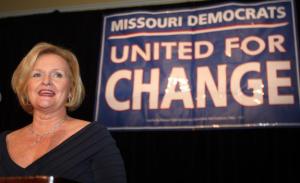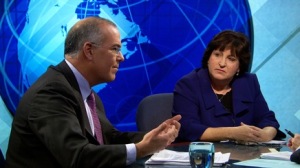According to a report of the Pew Center on the States (The Trillion Dollar Gap), the Kansas Public Employees Retirement System (KPERS) is in trouble – very serious trouble. Why? If you listen to the mainstream media, right-wing conservatives, so-called moderate Democrats (i.e., the Third Way), and various and sundry other sources, you would have to conclude that the cause of the state pension problems can be laid at the doorstep of those powerful, greedy, public employee unions.
However, “The unions as state budget busters hypothesis,” when considered in the light of objective research, can be easily falsified. For instance, Appendix B of The Trillion Dollar Gap is a listing of state-by-state data in the following categories: (1)” percentage of accrued liabilities funded, “(2) “unfunded liability as a percentage of covered pay roll,” and (3) “percentage of actuarially required contribution made, 5-year average.”
If your eyes are glazing over after that bit of “in the weeds” jargon, please stick with me for a bit longer. Kansas is shown to have funded 59% of accrued liabilities while New York has funded 107%. This simply means that Kansas is really falling short in the amount of money it should be putting into its retirement system to meet the obligations it has toward its retirees while New York is doing quite well in that regard.
The point here is that states are in financial trouble when they have huge debt obligations they can’t meet. The primary unfunded obligation facing states in trouble is in the area of pensions. New York, a strong union state, is not in danger of defaulting on its pension bonds or reneging on the promises made, through legislation, to its retirees. Conversely, Kansas, a quintessential right-to-work state, has a pension program, which, in order to survive, needs some real and immediate attention from its legislature.
“This is only two states,” you might say. But, if one peruses Appendix B of the Pew Center report, one will note that there appears to be no correlation between union strength in a state (i.e. right-to-work versus non-right-to-work states) and the financial condition of state pension programs. On the three measures mentioned earlier, states were given grades by the Pew folks from 0 to 4, with 0 being the worst to 4 being the best. Kansas and Illinois, for instance, received grades of 0, whereas New York and Ohio received grades of 4. I find it interesting that the newly elected Republican governor of Ohio has vowed to bust public employee unions by convincing the legislature to declare them illegal.
Research into KPERS reveals that many long-running issues that have nothing to do with unions are responsible for the near bankruptcy of the system. In a long conversation yesterday with an expert at the Kansas State Legislative Research Department, I learned that KPERS has been rendered unsound by a variety of factors, including, but not limited to, an incompetent actuary who, in the 1970s, led the legislature to believe benefits could be increased to a specific level but failed to indicate the adequate level of funding needed to meet the increased liabilities.
The legislature has not adequately increased the level of funding needed to keep the program sound. Furthermore, in the 1990s, the legislature, the KPERS board, and investment advisors made a decision to invest money in Kansas business as a form of eco devo. Not only did this strategy fail to earn a decent return, it caused losses in the amount of approximately $220 million dollars.
That quarter of a billion dollar loss, along with the 1 ½ billion dollar loss in the 2008 U.S./worldwide economic collapse, when added to the Kansas legislature’s failure to adequately fund the program, has placed the income of many Kansas retirees in jeopardy. Furthermore, you can’t blame the unions for the mess at KPERS. Rank and file union members did not make investment decisions; they did not bundle subprime mortgages into bonds and then give that toxic waste AAA ratings; and they did not produce an incompetent actuarial study.
I am told that there are 20 Legislative Post Audit Reports concerning the 1990s investments. I plan to get my hands on them. I also know some other people that know what has been going on and I plan to interview them. So stay tuned. You will be reading more on this blog about KPERS and how the Brownback Administration and the Kansas Legislature plans to make whole the retirees who have paid into the system. I do not intend to stand by and listen to the scapegoating of public employee unions that is becoming de rigueur these days.










